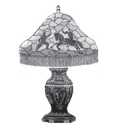Noon at Tiffany's
Authors: Echo Heron


A
LSO BY
E
CHO
H
ERON
NONFICTION:
Intensive Care; The Story of a Nurse
Condition Critical; The Story of a Nurse Continues
Tending Lives; Nurses on the Medical Front
NOVELS:
Mercy: a novel
MYSTERIES:
The Adele Monsarrat series:
Pulse
Panic
Paradox
Fatal Diagnosis
an historical, biographical novel

ECHO HERON

Noon at Tiffany’s is a work of historical fiction. Apart from the known actual people, events and locales that figure in the narrative, some of the names, characters, places and incidents are the products of the author’s imagination or are used fictitiously. Any resemblance to current events or to living persons is entirely coincidental.
Copyright © 2012 by Echo Heron
All rights reserved
Published in the United States by Heron Quill Press, LLC.
Noon at Tiffany’s:
an historical, biographical novel /Echo Heron
ISBN: 978-1-938439-71-1 (ePub)
Printed in the United States of America 2012
Cover design by Daniel Magil/
danmagil.com
Top cover photo by Steven Vermillion
Photo of Clara Wolcott courtesy of Linda Alexander
Bottom cover image: Tiffany Daffodil leaded lamp/designer:
Clara Driscoll/Telome4/CC-BY-SA 1.0
Interior images used by permission from Jupiter Images.

QED stands for Quality, Excellence and Design. The QED seal of approval shown here verifies that this eBook has passed a rigorous quality assurance process and will render well in most eBook reading platforms.
For more information please
click here
.
In memory of Clara Pierce Wolcott Driscoll Booth December 15, 1861 – November 6, 1944
When I see her mosaics, lamps and windows now, I see my sister’s soul. I have always thought of Clara as one of the special heroines of God’s world. We have been singled out to enjoy the blessing of her companionship; we have walked in her light. Her memory is a star that will move on before us to the end.
Emily Wolcott, 1944
I began writing this book in January 2007, after hearing a National Public Radio broadcast about the discovery of a cache of 1,330 letters written between 1853 and the 1930s. The majority of this collection is made up of the weekly round robin letters circulated among Clara Wolcott, two of her three sisters, Emily and Kate, and their mother, Fannie. What makes these letters so noteworthy is the secret revealed within their yellowed pages—that Clara was, in fact, the designer of the iconic Tiffany lamps and of many of the glass and mosaic pieces that Louis C. Tiffany claimed were his own designs.
For most of my writing life I have endeavored to champion remarkable women who unjustly go unrecognized simply because they are women. By the time I had finished reading Clara’s letters, in which she gives vivid accounts of her daily life in turn-of-the-century New York City, I felt I had to bring this incredible woman out from behind Louis Tiffany’s shadow and into her own light. There was no doubt in my mind that not only was Clara Wolcott an extraordinary woman, years ahead of her time, she was also unquestionably one of America’s most prolific and original artists.
Since Clara’s letters form the foundation of this book, I have used sections of the Wolcott letters and diary entries to fashion portions of the dialogue, story lines and scenes. I also relied on my own intuition based on my research into the events and mood of the place and time.
I derived my characterization of Louis Comfort Tiffany’s personality and psychology from the abundant source materials available, including but not limited to his biographers and memoirists. Although I relied on my research to form Louis Tiffany’s diary entries, they are conjectural, since few of his personal accounts are in existence.
In the instance of Clara’s visit to the church in Troy, NY, the particular windows I describe in that scene are invented, although in fact, Troy’s St. Paul’s, St. John’s and St. Joseph’s do have a magnificent collection of Tiffany Studios windows.
While I have tried to capture the essence of truth, if not always the precision of factual detail, in depicting the events and characters in this book, I have not hesitated to bend personalities, time, and events to suit the fictional needs of a novel. I trust what liberties I have taken will be forgiven.
If you will, take a closer look at the book cover. The pensive woman in the photograph is Clara. I think, after all these years of silence, she would be honored for you to read her story.
Table of ContentsRound robin (round rob•in)
Noun
a letter, notice, or the like, circulated from person to person in a group, often with individual comments being added by each individual in turn.
1888 ~ 1892
~ 1 ~
May 7, 1888
Tiffany Glass Company
333-35 Fourth Avenue at East Twenty-fifth Street,
Manhattan
A
TEAM OF WILD-EYED HORSES
rounded the corner at a reckless speed at the same moment that Clara Wolcott and her younger sister reached the middle of the intersection. Frozen in mid-step, Clara focused instinctively on the panicked driver, who stood on the dray’s platform, straining against the reins for control. She heard screams as the horses veered sharply at the last second, sending the overloaded cart up onto two wheels, where it teetered and then righted itself with a loud crash. The animals thundered past with only an inch to spare.
Clara let out a breath and tightened her grip on the handle of her portfolio, somewhat pleased at her increasing ability to take these daily death-defying events in stride. When she’d first arrived in New York, merely the sound of an approaching wagon had turned her weak-kneed. She gave her skirts a perfunctory shake and resumed her brisk pace through the cloud of dust.
Josie ran after her, clutching her hat. “For God’s sake, won’t you please slow down?”
“Prestigious businessmen such as Mr. Tiffany don’t like to be kept waiting by anyone, especially two poverty-stricken newcomers who come begging favors,” Clara shouted over the noise of the carriages.
“We aren’t poverty-stricken, and you aren’t a newcomer, Clara. You’ve been in New York for well over a year.”
“Which is why you should listen to me when I tell you that being late for an interview practically guarantees you’ll soon be poverty-stricken.”
Clara continued toward the Tiffany building, giving no indication that beneath her composed exterior, she was a mass of roiling nerves. It still didn’t seem possible that she was about to present her work to Louis Tiffany. If meeting the magnate wasn’t pressure enough, her mother and sisters were sure to have told every living soul within a fifty-mile radius of their farm in Ohio that she and Josie were, at this very moment, heading into an interview that would determine their fate. They would assuredly be the main topic of conversation at every supper table throughout Tallmadge and Kent for weeks.
They were halfway across the building lobby when a stout gentleman, intent on his pocket watch, collided with Clara, knocking the portfolio from her hand and the derby from his head.
“Watch where you’re going!” he growled, retrieving his hat.
Clara turned a withering eye on him. Even after a year of being subjected to the coarse manners that prevailed among the men of New York, she still had difficulty coming to grips with their disregard for women. No man in Tallmadge—or even Cleveland—would ever think of behaving so poorly.
“I beg your pardon, sir, but I think you would be better advised to go where you’re watching!”
“What impudence! Women shouldn’t be allowed to barge about the streets like wild animals!”
“And you, sir, need to be reeducated in the basics of how a civilized man should behave in polite society.”
His face suffused with color, he stalked off, his hat lopsided.
She retrieved her case, stealing a glance at her sister. Hand pressed against the middle of her chest, as if to smother the pain that often resided there, Josie was pale, her face beaded with perspiration. Clara averted her gaze. Any other day she would have insisted they sit and rest, but today she couldn’t allow Josie’s poor health to delay them. A position at Tiffany’s was her entrance into a world she’d dreamed of since the moment she realized her life’s purpose was to create art. If her sister wanted to fit into
the life of a New York artist, she would have to grow tougher skin.
Clara caught sight of herself in one of the mirrors that lined the lobby walls and stopped to make sure she was presentable. She’d gone without lunch for a week so she could afford to rent the blue taffeta gown that flowed over the length of her figure. Cut tight across her slender waist and hips, but draped full over the bustle, the garment was so recently out of fashion that only the most observant dressmaker would know it was last year’s style.